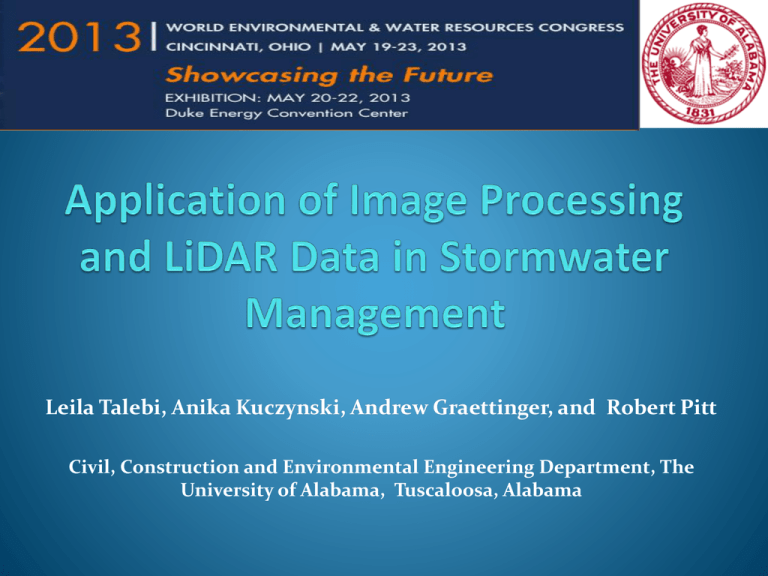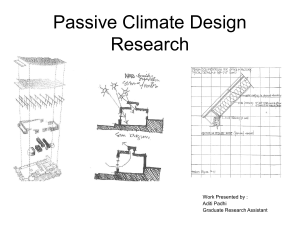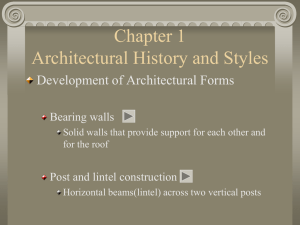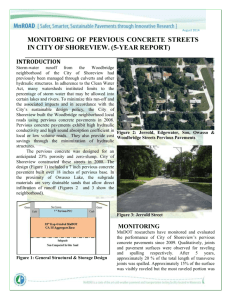Impervious Area Detection By LiDAR and Satellite Image
advertisement

Leila Talebi, Anika Kuczynski, Andrew Graettinger, and Robert Pitt Civil, Construction and Environmental Engineering Department, The University of Alabama, Tuscaloosa, Alabama Why is urban land classification necessary? Water quality issues Impervious vs. pervious surfaces http://ga.water.usgs.gov/ 2 WinSLAMM (Pitt and Voorhees, 1995) WinSLAMM: Source Loading and Management Model for Windows Estimate runoff quantity and quality Design stormwater controls 3 Objective Create a tool to facilitate urban surface classification, while maintaining reasonable accuracy and decreasing required analysis time. ArcGIS tool creation (ModelBuilder) Outcome Urban Classifications: Roofs Parking lots Streets Pervious areas 4 Image Types Satellite images at high (1-4 m) and low resolution Landsat TM/ETM/ETM+, IKONOS, SPOT, Quickbird Aerial photos Landsat Chesapeake Bay area Photo Credit: NASA 5 Digital Image Processing Per-pixel classifiers Maximum likelihood classifier Nearest neighbor classification Object-based algorithms Artificial neural networks (ANN) Classification and regression tree (CART) algorithms/decision tree learning Normalized Difference Vegetation Index (NDVI) Support Vector Machines (SVM) 6 Color Variables Combine RGB, YCbCr, and HSI models In addition to RGB, use: Luminance: Y Hue: H Saturation: S Intensity: I Advantage: more variables available for image processing more accurate result (Rottensteiner et al., 2002) 7 Image Processing Problems Similar spectral responses: Roof and pavement Soil and concrete or asphalt Tree coverage Shadows Viewing angles 8 LiDAR Digital Surface Model (DSM): generated directly from reflective LiDAR points (blue color in the Figure) Digital Terrain Model (DTM): depicts the pure terrain surface, filtering functions are applied to remove surface objects (red color in the Figure) NDSM = DSM – DTM 9 Methodology Data: Aerial photo LiDAR Centerline of streets Solution shapefiles for UA campus Streets, parking, buildings Approach ArcGIS 10.0 tools Partially automated image processing of nDSM and color band rasters 10 Process 11 ArcGIS Tools Raster Calculator Slope thresholds Curvature SetNull and IsNull ZonalGeometry Buffer Generalize Polygon Aggregate Polygon While/For loops 12 Case Study 13 Institutional Area Aerial photo Residential Area 14 Model Parameters Threshold Institutional Residential Saturation 20 18 Slope 70 40 Curvature 120 30 Area 100 70 Thickness 4 3 Buffer 3 4 15 Roof Classification 16 Pavement Classification At the end of roof classification, the roof polygon feature class is converted back into a raster for further analysis. Pavement areas were obtained by adding the darker saturation raster areas to the buffered centerline areas and subtracting the previously defined roof areas. Note that by using the freely available TIGER centerline feature class as an input data source, tree coverage of streets is not a source of error as in the case of sole image processing. 17 Institutional Area Solution by Manual Delineation Model Output 18 Residential Area Solution by Manual Delineation Model Output 19 Accuracy Assessment Overall accuracy : dividing the total number of correct pixels (the sum of the major diagonal) by the total number of pixels in the error matrix (Congalton, 1991). User’s accuracy : is a “measure of commission error” which is the probability that a pixel classified on the map correctly corresponds to the same category on the reference Producer's accuracy : is a “measure of emission” which represents the probability that a reference pixel is being correctly classified (Story and Congalton, 1986). 20 Error Matrix and Accuracy Assessment for Institutional Area Classification from manual delineation Roof Roof Parking 1,384,123 109 6,228 4,356 820,779 17,435 Parking 56,473 47,385 16,95,687 Pervious 83,173 Classification Street from model Street Total Producer's accuracy (%) Pervious Total 134,441 1,524,900 70,199 User's accuracy (%) 90.8 912,768 89.9 170,218 1,969,764 86.1 49,703 280,406 3,221,886 3,635,168 88.6 1,528,124 917,976 1,999,756 3,596,744 8,042,600 90.6 89.4 84.8 89.6 Overall accuracy: 88.6% Matrix entries represent number of pixels. 21 Error Matrix and Accuracy Assessment for the Residential Area Classification from manual delineation Roof Roof Parking Pervious Total 245,942 2,870 2,112 53,927 304,852 80.7 0 359,605 14,825 92,066 466,496 77.1 Parking 33,428 4,013 146,311 21,719 205,472 71.2 Pervious 27,850 76,980 47,488 815,143 967,460 84.3 307,220 443,468 210,736 80.1 81.1 69.4 Classification Street from model Street User's accuracy (%) Total Producer's accuracy (%) 982,856 1,944,280 82.9 Overall accuracy: 80.6% Matrix entries represent number of pixels. 22 Residential Area 300,000 Results 250,000 Model 150,000 Solution 100,000 Institutional Area 1,000,000 50,000 800,000 0 Roof Parking Pervious Street Area (ft2) Area (ft2) 200,000 600,000 Model Solution 400,000 200,000 0 Roof Parking Pervious Street 23 Conclusions Land use classification is necessary to accurately calculate water quality and runoff volumes. This work presented an approach to classify land use as roofs, streets, parking lots, and pervious areas based on analysis of LiDAR data, aerial photographs, and TIGER line data using ArcGIS 10.0 tools in a ModelBuilder program. Two case studies in Tuscaloosa, Alabama, including an institutional land use, and a residential land use. The accuracy assessment shows high value of overall accuracy for both land uses; 89% and 81% for the institutional and residential land use test areas respectively. 24 Conclusions The comparison of output areas for each category (roofs, streets, parking lots, pervious areas) to known areas (manually delineated) showed highest result accuracy for roof areas. Therefore, this model is very suitable for determining roof areas for designing cisterns and drywells for roof runoff stormwater harvesting systems. Although the other three area estimates are less accurate than the roof result, they are sufficiently accurate (< 6% error) for most preliminary design purposes. 25









